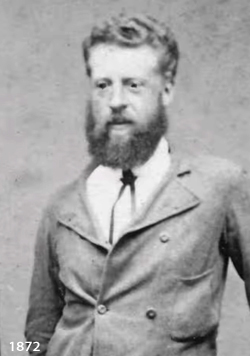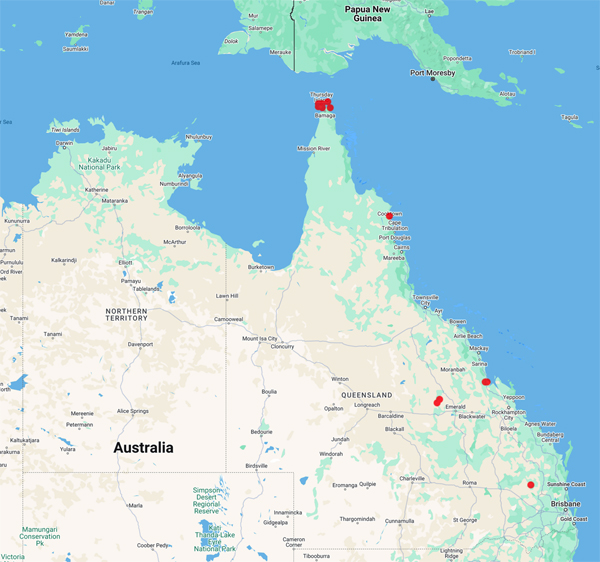
Council of Heads of Australasian Herbaria
Australian National Herbarium
Biographical Notes
 |
Council of Heads of Australasian Herbaria |
 Tate, Thomas (1842 - 1934)
Tate, Thomas (1842 - 1934)Born in 1842 in Northumberland, UK; died on 27 January, 1934 in Rockhampton (aged c.92)
He was educated in South Wales (UK), and then proceeded to the Edinburgh University at the age of 17 to study medicine. Four years later, without sitting for his final degree, young Tate accepted the position as doctor (unqualified) on a whaler, and sailed from Peterhead to Spitsbergen, 10 degrees from the North Pole.
The voyage unsettled him for further study, and on completion of it he was appointed medical officer to the sailing ship Celeno, bound for Dunedin, New Zealand. That was in 1860 and Mr. Tate was 23 years of age.
On arrival in New Zealand he was appointed dispenser to the Invercargil Hospital.
But the gold rushes in Victoria were calling, and finding an educated mate he started mining in New Zealand, and did fairly well, eventually selling out and going to Melbourne, and on arrival, hearing that an expedition was setting out for New Guinea, young Tate offered his services as medico, and was accepted.
He left Sydney in the ill-fated Maria in January, 1872. The Maria encountered bad weather and went ashore on Bramble Reef. The captain and six men in a boat headed for the mainland, and a number of the crew left the wreck on two rafts. Mr. Tate was in one of the boats. The rafts were washed ashore at what is now named Maria Creek, where the Aboriginals murdered 10 of them, thirteen men were drowned, and 12 were unaccounted for.
There were 76 men all told on the Maria. Mr. Tate was landed on Hinchinbrook Island, eventually got over to Cardwell and subsequently joined Captain Moresby and Lieutenant Smith, of the survey ship Basilisk, in a search for the survivors.
It was from the little town of Cardwell that Mr. Tate got in touch with Mr. Hann, then organising an exploration party in the North of Queensland, and he was appointed botanist and naturalist to accompany the party to investigate the interior of Cape York Peninsula.
It was a rough trip and writing of it in 1873, Mr. Tate said: "From the first we had been on half rations, and during the last six or seven weeks we were glad to eat snakes, lizards, white ants, etc. You may fancy the quantity of meat we consume daily when a ham was divided into 62 meals for a party of six. We, of course, ate it raw, as it would lose too much vitamin in cooking. When we were reduced to three weeks' supply of food (quarter rations), Mr. Hann deemed it advisable to give up the attempt to reach Cardwell by the coast, and struck for the Palmer. We caught a lot of fish, and secured a kangaroo, a perfect godsend." This expedition occupied eight months. (read more here)
Mr Tate returned to Maryvale [Qld] with Mr Hann, and his botanical collection was sent to the Botanical Gardens, Melbourne. Later he joined the Educational Department, and in 1874 took charge of his first school at Oakey Creek, where he married Grace Fortune, of Bendigo, Victoria. He was transferred to Jondaryan [Qld], where in 1883 his wife died, leaving eight children. Mr. Tate married again.
Later Mr. Tate went to Rocklea [Qld] where in a big flood he contracted asthma and was transferred to Plains, then to Normanton, and from there to Thursday Island, and at the age of 64 he was sent to take charge of the school at St. Lawrence, where he remained until 1918, and after 40 years at the Educational Department he retired. Since then Mr. Tate resided in Rockhampton.
It is interesting to note that Thomas Tate was a cousin of the more famous South Australian scientist and botanist, Ralph Tate (1840-1901).
Thomas was honoured in the plant name: Premna tateana F.M.Bailey, Bot. Bull. Dept. Agric., Queensland 4: 15 (1891) (now called Premna dallachyana).
Source: Extracted from:
Townsville Daily Bulletin (Qld)
, 14 February 1934 , p 7, Thomas Tate (1842-1934)
https://www.paulturnbull.org/dalton/biogs/E000950b.htm
Pers.Comm. Robyn Barker (2024).
Portrait Photo: Norman Taylor Collection, MS 16289, Australian Manuscripts Collection, State Library of Victoria.
Data from 53 specimens
